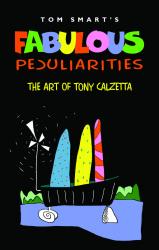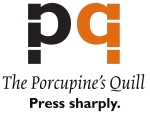
Fabulous Peculiarities traces the artistic evolution of Canadian artist Tony Calzetta, whose penchant for experimentation and ability to both work within and subvert the rules has resulted in a unique and complex but unified aesthetic.
About the Book
Over the past four decades, Canadian artist Tony Calzetta has developed a bold style and a unique visual lexicon. In Fabulous Peculiarities, veteran author, art gallery director, curator and columnist Tom Smart teases out Calzetta’s many and varied artistic influences. Smart also examines how the artist has made efforts to engage audiences in the interpretation of his works, resulting in unique and complex visual narratives. As Smart explains, the culmination of this interest in visual narratives is Calzetta’s collaborative livre d’artiste created with award-winning poet Leon Rooke and printmaker Dieter Grund: a zany, surprising masterwork entitled How God Talks in His Sleep and Other Fabulous Fictions.
Read an Excerpt
From the Introduction
As is painting, so is poetry
Horace, the ancient Roman poet born some two thousand years ago, was one of the first writers to compare the arts of painting and poetry. Advocating strongly for radical and innovative ways to appreciate literature, he encouraged readers to transfer to poetry the same qualities that give pleasure in painting and visual arts, evoke mood and stimulate thought. Just as paintings can be read and understood either through close viewing or from a distance, Horace proposed, so too one could decipher a poem with both a close reading and with an eye to the bigger picture—the piece as a whole. "Ut pictura poesis"—"As is painting," he declared, "so is poetry."
This is a core idea that animates the drawings, paintings and prints of Canadian artist, Tony Calzetta, and which has inspired the poetry and prose of his author colleague, neighbour, friend Leon Rooke. Together, Calzetta and Rooke have bred book works whose parents are drawing, painting, printmaking and poetry. Their 2009–2010 offspring, How God Talks in His Sleep and Other Fabulous Fictions and Peculiar Practices are something else altogether: amalgamations of voices and styles, modes and meanings, that are truly operatic in their scope and that embrace many artistic forms.
Their creative marriage began in 2007 when Calzetta, and Dieter Grund, publisher at Presswerk Editions, were casting about for a project on which they could work collaboratively. The discussion evolved to include Governor-General Award winning author Leon Rooke. Together, the trio set their sights on creating a livre d’artiste. The creative process, however, would be reversed from the usual flow of words inspiring images; during a lively conversation, Calzetta suggested to Rooke that he (Rooke) respond to his (Calzetta’s) drawings by writing whatever came to his mind and flowed through his pen. Drawing preceded word, resulting in a kind of word-based lyrical translation of the artist’s lines that were the muses for the poet’s imagination. Rooke chose nineteen and set down a suite of raucous tales. The image muses were selected from twenty-five studio sketches that Calzetta randomly selected from his production.
Rooke’s mastery of language is matched by his absolute familiarity with poetry’s rules and conventions. Rather than be content with exploring blandness wrapped in simple poetic verse, his deep appreciation of form and craft takes him and his readers on trips across a wide rainbow comprising lyrics, odes, sonnets and just about every other way poetry is put together. His bawdy, irreverent, humorous tales teach lessons by engaging the mind and body on equal terms.
When paired with Calzetta’s prints, drawings and paper sculptures, a very mysterious thing occurs. It is as if the artist’s simple, abstract lines and odd, allusive shapes that float and sway in and around his prints, drawings and paper sculpture compositions turned into alphabets of very different characters.
How God talks in His Sleep and Other Fabulous Fictions and Peculiar Practicesexplore the propinquity of image and word. The offspring of this creative mash-up of picture and poem is entirely new kinds of texts and objects altogether. The pages themselves have meaning in the very selection of components comprising the paper pulp—pulped dollar bills, twigs and leaves from Cézanne’s garden, for example. Primary colours of end papers dazzle brilliantly and clash with each other. Prints are made from etching presses and from ink jet printers. Scrolls and pop-ups, folded origami-like shapes all collide with cutout doodles. These are the icons of a wholly new way to read and write, and to make art.
The manuscripts comprise suites of printed pages, made with the various technologies associated with woodcut printing, digital printing, and etching. Pictures rest beside typescript, sometimes enfolding it in pictorial parentheses. On other pages, texts of various sizes range around the page, complementing the images, and giving the sense of pictorial depth beyond the surface of the rag paper. The process of reading this manuscript is, in the first instance, visual. The experience of unlocking its meaning is sensual. As if they were clothing stripped away to reveal the body comprising text and image, things are taken away to unveil a truth. In and out, the focal points shift as letters and words emerge and recede in the imaginative spaces behind the picture plane, and as printed forms collide with one another in collage-like juxtapositions. The effect looks like two alphabets co-existing on the same page—one letter-based, readable and typographic, the other pictorial, hermetic and metamorphosed from a personal, expressive artistic style.
Reading these two books leads inevitably to the questions: Where do these fabulous books come from? What are their artistic lineages? And what, if anything, do they mean?
Let’s see what we can find out by taking a trip back four decades to the beginning of Calzetta’s career as an artist, and by tracing the development of his artistic career to the point where God talks in his sleep.
(Continued in Fabulous Peculiarities...)
About the Author

Author, art gallery director, curator, columnist and special advisor to art galleries and museums, Tom Smart is especially noted for his award-winning critical biographies, catalogues and monographs on Canadian artists. To date, Smart has written about painters Alex Colville, Christopher Pratt, Mary Pratt, Tom Forrestall, Miller Brittain and Fred Ross; graphic novelist George A. Walker; and sculptor John Hooper. Smart has worked in art galleries and museums across Canada and the United States, among them the Beaverbrook Art Gallery, the Winnipeg Art Gallery, the Frick in Pittsburgh, the Art Gallery of Sudbury and the McMichael Canadian Art Collection where he was Executive Director from 2006–2010. Smart’s essay ’The Wood Engravings of Rosemary Kilbourn’ was recently published in the Devil’s Artisan. His bi-weekly column ’The Curator’ appears in the Saint John Telegraph-Journal.
For more information please visit the Author’s website »
You Might Also Like
Buy in Print
To get this book in print, order from your favourite indie bookseller, or
buy online from our distributor, UTP »
